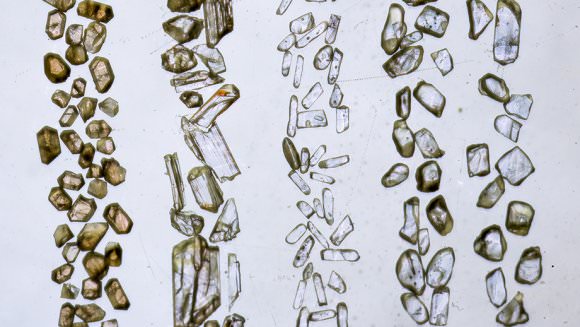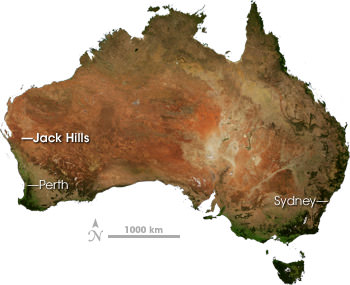It might seem unlikely, but tiny grains of minerals can help tell the story of early Earth. And researchers studying those grains say that 4.4 billion years ago, Earth was a barren, mountainless place, and almost everything was under water. Only a handful of islands poked above the surface.
Scientists at the Australian National University are behind this study, led by researcher Dr. Antony Burnham. The mineral grains in the study are the oldest rocks ever found. They’re 4.4 billion year old zircon mineral grains from the Jack Hills of Western Australia, where they were preserved in sandstone formations.
4.4 billion years ago, the Earth was in what is called the ‘Hadean Eon’. This time period is poorly understood, because there is no rock record dating from that time. This is where the zircon mineral grains come in.
“The history of the Earth is like a book with its first chapter ripped out with no surviving rocks from the very early period, but we’ve used these trace elements of zircon to build a profile of the world at that time.” – Lead Researcher Dr. Antony Burnham, Australian National University
In a sense, these zircon grains are the missing pages.
Zircon’s chemical name is zirconium silicate, and it’s found almost everywhere in the Earth’s crust. This study focuses on what’s called detrital zircon, which is formed in igneous rocks, but then survives over time until deposited in sedimentary rocks. Zircon grains are typically very small, about 0.1 to 0.3 mm in size.

Zircon commonly contains traces of thorium and uranium, which means they can be easily dated by modern dating methods. Zircon can survive a lot of geologic processes like metamorphism, which explains their usefulness in studying the early Earth. They’re not easily destroyed, and they have a story to tell us.
The zircon grains were crystallized in magma about 500 million years after the Earth formed. As a result, they offer rare insights into conditions on Earth at the time. The zircon grains in question are referred to as detritus, because they formed in magma but were deposited in the geologically-important sandstone at Jack Hills, Australia. The detritus grains were compared to a second type of zircon grain which were formed directly in the sedimentary formations.
By distinguishing between the two types, researchers gain a new geochemical tool to understand early Earth.

“We used the granites of southeast Australia to decipher the link between zircon composition and magma type, and built a picture of what those missing rocks were,” he said.
“Our research indicates there were no mountains and continental collisions during Earth’s first 700 million years or more of existence – it was a much more quiet and dull place,” says Dr. Burnham from the ANU Research School of Earth Sciences.

“Our findings also showed that there are strong similarities with zircon from the types of rocks that predominated for the following 1.5 billion years, suggesting that it took the Earth a long time to evolve into the planet that we know today.” The team’s results are published in the journal Nature Geoscience, and is titled “Formation of Hadean granites by melting of igneous crust.”

This is not the first time that ancient, detrital zircons have been at the center of scientific studies of early Earth. In a previous study, they were used to conclude that Earth had a significant hydrosphere 4.3 billion years ago.


If this evidence for an ocean is sustained it seems to support the Grant Tack model. Right now, it is understanding, the dominant proposal is that very early – in a few million years after the formation of the solar system Jupiter had plowed well into the inner solar system from (type 1?) planetary migration which pushed the then larger asteroid belt including ones from beyond the ice line into the inner solar system delivering the majority of Earth’s water. That’s the Grand Tack Model which nicely tucks and sets up for the later Nice Model. The old idea of comets being the source (and coming even later after Saturn caught up to Jupiter and the pair did a (type 2?) migration back out) comes later when they disrupted Uranus and Neptune and scatting the outer minor bodies who’s survivors are the Kuiper belt.
But that “it was a much more quiet and dull place” comment… well maybe from the vantage of islands and mountain – but this was still the era of large bodies smashing around. I’d bet meteor showers would have been incredible them (and not from comets so much.) And Jupiter would have been very large in the sky, no?
Someone should do a video of what the night sky would have looked like…
See https://www.youtube.com/watch?v=X64ZoijzTWI for lecture ideas around this.